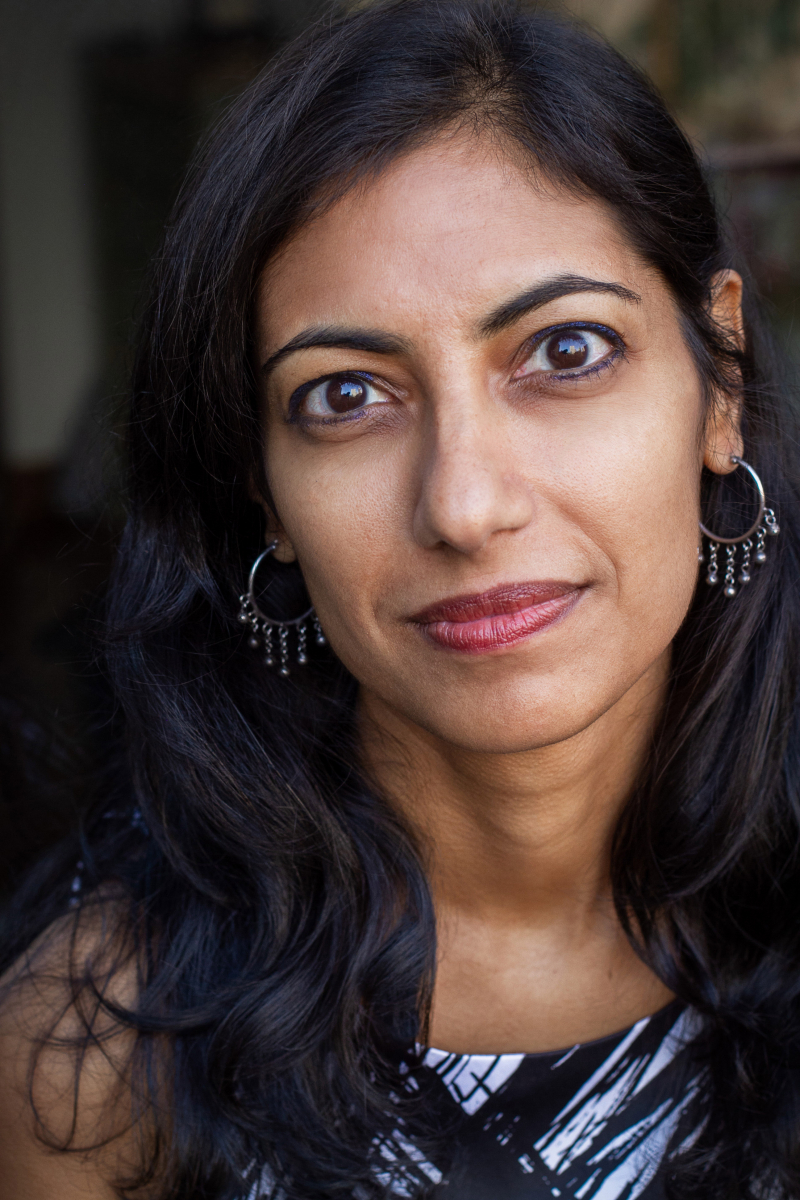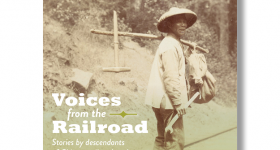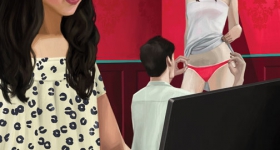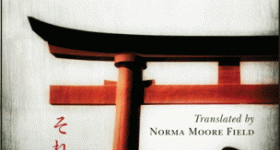Sejal Shah’s debut collection of essays, This Is One Way to Dance, was published this past June by the University of Georgia Press in the midst of the intensifying COVID-19 pandemic and protests against police brutality. In the months that followed, poet Ansley Moon corresponded with Shah about how her new collection came together; the lyric essay as a hybrid and nonbinary resistance to fixed genres; what it means to write and create in this cultural moment; and about home and belonging. The following interview is edited for length and clarity.
Ansley Moon: Your book spans two decades, as well as various continents and multiple cities. Could you describe the process of excavating your own work in order to create the book?
Sejal Shah: I began the process by considering essays and stories I wrote in my late 20s while in graduate school up through essays I completed last year. Five of my essays in This Is One Way to Dance began as short stories, but after revising and publishing them, I reclassified them as essays; some of my essays became prose poems, some of my essays did not fit the book.
My original manuscript was hybrid: both stories and essays, a bit like Tyrese Coleman’s How to Sit: A Memoir in Stories and Essays, but without her note to the reader, which provided a genre-straddling rationale. In 2016, Valerie Boyd, co-editor of Crux, the literary nonfiction series at the University of Georgia Press, reached out to me to see if I had a nonfiction manuscript. So, I divided my hybrid prose manuscript into a nonfiction-only manuscript and a story collection.
Looking through years of essays, I pulled prose with an eye to finding a perspective or point of view that still felt resonant, even if my thinking had changed in the time since it was written. I wanted to keep some sort of commentary on the time and place and issues that concern me with regards to geography, culture, language, migration and loss. I then looked for essays that echoed or complicated the themes and tones of what I already saw in the manuscript: race, place, school, the search for home, the centrality of friendships, mentors and other important relationships outside of marriage and family; the pageantry and heteronormative script of weddings; what we see and don’t see in curriculum and education; and the struggle to center oneself in a country that sees nonwhite as other.
I decided to begin the book with an opening poem (comprised in part from lines salvaged in revision) followed by what had once been a story. This Is One Way to Dance is a marriage of more recent essays and earlier ones that were revised, cut open and stitched together or apart. There are a few other poems I wish I had included — side B of the album, the ghost manuscript. It was not a matter of just taking the essays I’d written and or published over the last 20 years; it was a matter of collecting, winnowing, revising, polishing. One of the essays that I’ve heard from a lot of readers about was a late addition to the book. “Your Wilderness Is Not Permanent” is an essay about going to Burning Man. It was not in the original manuscript, which went through two rounds of blind review. I had worked on it outside of the book; Conjunctions published it last year. Bradford Morrow’s sharp and generative editing helped me finish and find the final shape of the essay. I’d really struggled with it. I knew it was a strong essay, but I wasn’t sure if it would fit into the book. It turned out to be a key part of the narrative.
I also wanted to show a particular diasporic Gujarati American experience in western New York in the 1980s. Rather than be positioned as representative in the way that publishing anointed Jhumpa Lahiri’s work as the “Indian American/South Asian American” story, I wanted to assert this is one way to live a life, one way to navigate multiple cultures, one South Asian American experience, one girlhood in a particular suburb of a midwestern city in New York state on the shores of a Great Lake. To not speak for anyone other than myself.
My friend, writer Wendy Call, suggested ordering the essays by when they were written instead of chronologically or by when they were published. That order and ensuing timestamps for the essays composed the internal architecture and logic of the book.
I could create a different kind of book by choosing essays I wrote over the last five or 10 years in a different order with a different introduction and a different cover; what is hardest for me is to accept I made this version from these decisions and let it go. My book is a record of my perspective at the time I put the book together in 2019. We are in another ti me now. It feels like a different era.
me now. It feels like a different era.
AM: You write in the introduction to the book, “I don’t subscribe to the notion of fixed genres — not when I and others move from one culture to another, from one kind of dance to another; from what looks like a poem to what looks like an essay to what could be a story. The world wants to know where to place you, how to classify you. I began my writing life as a poet and later turned to prose. In the last several years, for me, creative nonfiction has encompassed the wildest field of voice, thought and performance. I view the essay as hybrid and nonbinary, the aesthetic as queer.” This is probably one of my favorite descriptions of the essay, the lyric essay, and in so many ways, it reminds me of dance, of movement and even resistance. How does this resistance come into play in your writing?
SS: Thank you so much. I worked for a long time on the introduction. For me, resistance came in terms of pushing back against disciplinary boundaries and classifications: how genre was defined and defended in MFA programs and publishing and how my work, for as long as I can remember, certainly since graduate school, did not seem to fit in the genres or disciplines as I encountered them. I asked poets Sarah Gambito and Cathy Park Hong to help me launch my book — and I think that in part that was reclaiming my earlier life and identity as a poet. Sarah, Cathy and other poets read and recognized some of the essays as prose poems and called them as such. And that also felt like a kind of resistance and support. Though I had been known as a poet while growing up and in college, my writing did not fit the prevailing aesthetic in poetry at UMass; that was okay, I was there on the fiction side of the MFA program. I also had to contend with sexual harassment. I learned I needed places outside of creative writing to survive as well as interdisciplinary spaces like Asian American Studies, Ethnic Studies, American Studies, Women’s Studies and non-academic spaces like dance and yoga classes. These spaces and interdisciplinary work outside of my university became sites of resistance and community-building for me.
I think a lot about self-determination and self-definition. I’m late to the term intersectionality, but I attended a women’s college and found my voice through reading and speaking in interdisciplinary spaces. The lyric essay, a term I first heard through poets Philip White and Lisa Williams, felt as though it was a form that could hold my penchant for images, compression and the experience of writing around and through traumatic experiences in which the language itself fractures. Lyric essays showed me a way to hold space for silence, utterances and the unsayable.
In these essays I did not directly address some of the complexities of experience about class, sexuality, power, speech and silence in academia and in my family and culture. I identify as queer and bisexual. My writing community, my friends, my partner all know this, but I chose not to name it as an identity category in the book or in promotion. It’s something I’ve been ambivalent about writing, because of my traditional and religious parents. I did not name my queerness directly in my book, perhaps out of deference to their conservative beliefs, my father’s compromised health, and out of respect for our sometimes-difficult relationship, but I wish I had, actually, because it’s an important lens. I tried to signal my positionality, politics and aesthetics through claiming the genre itself as queer and nonbinary, ending the book on a note about the legalization of gay marriage on my wedding day and exploring my ideas about genre, politics, legibility and publishing in companion essays, which appeared close to when Dance was published. I wrote about genre slippage and hybridity in a craft capsule for Poets & Writers Magazine called “Breaking Genre.” I felt fewer rules and restrictions in nonfiction than I did for poetry and fiction, maybe because I didn’t study nonfiction (my MFA was in fiction).
AM: I appreciated how you made the connection between the Immigration and Naturalization Act of 1965 (Hart-Celler Act) and the Civil Rights Movement in your essay “Matrimonials.” For many young Asian Americans and South Asians, they are having conversations about race and Blackness with their families, some for the first time. When we were in the process of setting up a time to chat for this interview, in our correspondence, you wrote, “I want to take a step back and do some reading and thinking about this current moment and maybe how my book fits into it — and how we as Asian Americans can show up and do concrete things to combat colorism and anti-Blackness in our communities and in ourselves.” Could you talk a little about that process?
SS: My spouse, Raj, is dark-skinned and we’ve talked about colorism in our community and how often we were told to stay out of the sun in the summer — the fear of getting dark. I mean I wish I had worn sunscreen to protect myself from sun damage, but the emphasis on light-skinned as favorable always troubled me.
The origin of Asian American Studies as a site of resistance, its connection to Ethnic Studies, Black Studies and the Civil Rights Movement of the 1960s — this is not common knowledge and so there’s always a layer of explanation. My virtual book tour ends in December and I’m looking forward to more time to read and make explicit in my future writing some of the authors whose work is central to my understanding of community, health and justice. I also want to write more about Rochester, which is where I’ve lived over half of my life, and which is a place that’s racially and socioeconomically hyper-segregated. Through research and using some of my own experience and those of others whose stories don’t fit neatly into the dominant narratives, I know there’s a way to tell more nuanced stories.
I recently reread journalist and media producer S. Mitra Kalita’s “Before You Can Fix Your Newsroom, You Need to Fix Your Life” and heard her speak at the SAJA (South Asian Journalists Association) gala this fall. Mitra referenced her father who would say we [South Asians] would not even be here without the Civil Rights Movement. She talked about his reading Baldwin and understanding our place in the United States is inextricably tied with the history and struggles of Black Americans. Twenty years ago, in graduate school, I read Vijay Prashad’s The Karma of Brown Folk. More recently, I reread Shailja Patel’s Migritude (Kaya Press, 2010), which has a terrific foreword by Prashad and amazed me with its ability to enact how personal and colonial history are intertwined. Migritude grew out of performance and includes poetry, images, a shadow book, a timeline and interviews, which provide context. Migritude made me consider how a story can be told and made me want to write into my personal archives and to be more daring in form.
One of the local newspapers asked me to write an article about my thoughts on Kamala Harris as the daughter of an Indian immigrant (and relate it to my book). My feelings about her are not based on the fact that we both have a parent from India and would take some time to unpack. But I did notice that the local paper only saw a natural tie-in for an article about my book once we had a Vice President-elect who is a Black woman with a parent who emigrated from India. Though I have written about identity, at this point in my life, I am more interested in what people do, how they serve others and what their politics are, than where their parents are from.
AM: One of the things that struck me about your work is the conversations between people and places. In your essay about Rochester, “Six Hours From Anywhere You Want to Be,” you wrote, “In her novel, Jasmine, Bharati Mukherjee wrote, ‘The world is divided between those who stay and those who leave.’ I first read those words over 20 years ago. Even then, I wanted to be someone who left. I did leave home and kept moving. I left, but more fundamentally I am someone who stays. I am someone who returns.” In your writing, there is a gravitational pull towards Rochester. In another essay, “There Is No Mike Here,” you write, “I wrote poems then about what I thought about: how to locate, claim or create what or who is home — how you learn where and to whom you belong. It is still what I think about obsessively.” In many ways, I think these two quotes are representative of your entire book. After writing about these ideas, home and kinship, perhaps for 20 years, are these still your influences?
SS: I do still think about this a lot. We live in a culture fixated on the promise of the American Dream, the nuclear family, outward markers of success, but in this moment and before, I have been thinking about how to define home and community differently. Who are we outside of our jobs? A decade ago, I lost not only my job but also my career and identity as an academic. I was 37 and single. I felt like a failure. Or was I just a person making a life at a moment of transition? Where did I belong? I’ve been thinking about community beyond family and beyond the immigrant and religious community in which I grew up; how do we extend our definitions of kinship beyond identity, race, ethnicity, religion and culture? A book that’s been meaningful to me on this subject is by Oakland-based Black activist, storyteller, abolitionist and former Rochesterian, Mia Birdsong: How We Show Up: Reclaiming Family, Friendship and Community. It was also published in June. I have longtime friendships which have been an important part of my life and the making of This Is One Way to Dance. I was able to write some of this book because I had a place to live when I lost my job. I moved back in with my parents — this book exists because of my family and their support. I was also able to revise the manuscript, gather permissions and manage all the other parts of publication because I have health insurance through my partner. It was the first time in many years that I was working, but not teaching, full-time. With the pandemic making visible the extreme strain on people — especially women, parents and teachers, especially those of us with invisible disabilities, neurodiversity, older parents and managing mental health care, I’m never not thinking about home and kinship.
AM: How has it been publishing your work during a global pandemic and during the protests against police brutality?
SS: It has been challenging, but it’s the only experience I’ve had publishing a book. I feel like we’re in another world, a sci-fi novel, an altered reality, but it’s also our world. We are seeing the results of years of living under white supremacy. It’s a necessary rising up and pushing back. Though most of my travels and book events were canceled, it’s small in this time of great suffering. I’m thinking of Arundhati Roy’s words: The pandemic is a portal. We have an opportunity to make some changes in this pause. I’ve been moved by the protests against police brutality and also wondered at why it has taken so long to get here.
There’s so much we have not dealt with as a country: inequality in healthcare, structural and systemic racism, public education by property taxes. Climate change, pollution, corporate greed and the lack of regulation of industries from tech to Amazon to plastics. As someone who is Hindu and grew up with the concept of karma, it feels as if we, as a country and a culture, are in a moment of reaping what has been sown, what has come to a boiling point, to an opposite reaction. Karma. Kali Yuga. Who decides who counts?
As someone who is Hindu and grew up with the concept of karma, it feels as if we, as a country and a culture, are in a moment of reaping what has been sown, what has come to a boiling point, to an opposite reaction. Karma. Kali Yuga. Who decides who counts?
On a personal level, I’ve been moved by letters and emails from strangers, old friends and former teachers. One friend from graduate school, Andrew, wrote me a letter and sent me his copy of my book after he had read it for me to sign. I could read his penciled annotations and comments, underlining.
AM: Now that you’ve published This Is One Way to Dance, what are you working on now?
This summer, for Electric Literature, I made a reading list of books that had kept me going during some difficult years in my life. My introduction for EL also made me consider omissions, silences and gaps in Dance. I am beginning to write more about mental health: the cost and labor of managing invisible illnesses, chronic pain, neurodiversity including ADHD and mood disorders, particularly if you present as high-functioning and able-bodied. I am considering the performance of wellness and also the ways in which racism plays out on Black and Brown bodies, the consistent inability of medical professionals to value Black lives, to register complaint as valid. I’m thinking about Daniel Prude, the Black man killed in Rochester earlier this year, suffocated by the police, after his family had called the police because of his psychosis. He needed help. Those whose pain is not seen. About both not being seen or if you are seen, being misheard, misdiagnosed, mistreated.
I’m revisiting my story collection to add images and artifacts to the text itself. Short stories are magic, kinds of talismans. I miss the scope of fiction, of imagination freed from a specific relationship or adherence to facts, self or autobiography.
Credit for Shah's author photo: Preston Merchant










Comments